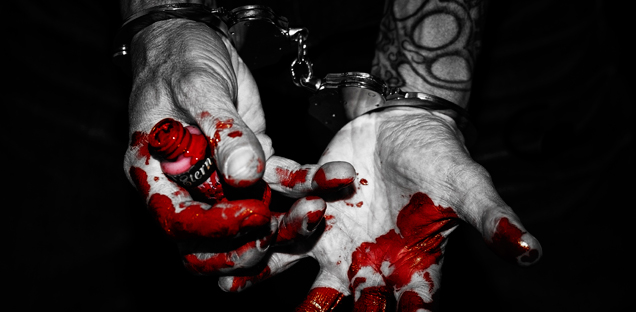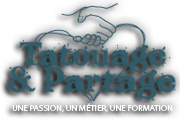
Tension kept rising in recent months around the topic of colored inks in France.
Hello everyone,
Tension kept rising in recent months around the topic of colored inks in France. In fact, the prospect of a meeting between the President of Tatouage & Partage and officials at the French Ministry of Health and Social Affairs ignited strong reactions on social networks a few days ago.
I have not doubt that at the time, many of these inflammatory comments went a bit further than their authors really meant, and I believe it's time I set the record straight with additional information.
Needless to say that we are not new to the world of tattooing ― Stéphane's credentials are well known, and his experience in this career puts him in the right place to present valid arguments to defend tattooing.
Since monarchy was abolished in France in 1789, each and every citizen of our country is given a chance to express themselves and to address elected officials and reach out to associations.
Diversity of opinion is what makes France a great nation. This diversity is supposed to allow a dialog to take place between people with different ideas, and people defending different values they all believe in.
In the economic world, with MEDEF and CGPME, between associations like Secours Populaire and Secours Catholique, and between workers' unions like FO ou CGT, you will encounter entities with completely opposing views that nonetheless strive to defend and protect a common interest, market or trade.
The SNAT, a non-profit association, just like Tatouage & Partage, has accomplished a lot for tattoo professionals since its inception, and we must acknowledge the efforts and the work carried out by its members.
I am however puzzled by those who have pegged SNAT against our association. I feel as if they may have misunderstood the principles of the association to which they belong and represents them.
But a few months back, when the government reached out to SNAT, seeking their input regarding the topic of colored inks, all they heard was a demand to drop the law. This is not possible, because France has an obligation to submit and conform to the European legislation. This failure of the tattooing community to provide feedback was confirmed to Stéphane and to Senator Jarlier during their meeting of December 12.
Tatouage & Partage had commissioned a consultant weeks ago, in an effort to analyze this complex issue. And as it turns out, the European legislation had simply been misinterpreted. After listening to our arguments, the cabinet of the minister agreed with our terms, so that colored inks certified by a European laboratory will be legal for use, as long as they don't contain products that are forbidden in Europe.
By engaging political leaders such as Senator Pierre Jarlier, we were able to mobilize his network and get quick access to the right people at the government level.
After the Copenhagen congress, Tatouage & Partage had reached out to other association leaders (namely the president and the secretary of the SNAT), in an effort to gain access to the files the SNAT had prepared regarding the impending colored ink problem.
We were hoping to compare these files to the findings of our consultant and shed some light on the alarming situation. We found it improbable that the files' analysis and its compelling body of evidence could have failed to yield results when submitted to the proper people at the government level. The files would have been a great tool during our meeting with the government officials by bringing a new perspective on the situation.
The SNAT wasn't interested in sharing with us the results of its study and its conclusions; something other associations usually find a common ground for, especially when working on finding a solution to a common problem.
We were left with no other option than ask our own consultant to run a thorough investigation by procuring all relevant European and French law documents in an effort to understand them. He did so in record time under an pressing deadline, assimilating all information and identifying flaws, weaknesses and possible loopholes in the various texts. Our consultant was able to highlight a number of factual elements that could be verified and that could lead to a concrete proposal made within the time constraints set by the ministry. We then reached out to the Senator who helped us organize a meeting with the office of the Minister of Health.
As is often the case, only three people were present at the meeting: Tatouage & Partage President Stéphane Chaudesaigues, Senator-Mayor Pierre Jarlier and our consultant.
Following our unsuccessful attempts to collaborate with the SNAT association, we launched and personally funded an investigation over the last two months. It resulted in a set of concrete proposals that reflect the needs and concerns of our profession. Our proposals were based on existing legislation currently in place in other European countries such as Germany.
From the onset of the project, we were interested in reaching out to Germany's DOT and learn or assimilate their approach to the problem. We deemed it a necessary step in the elaboration of a proposal relevant at the European level. We were surprised to find out that the SNAT had never contacted the DOT or other associations in Europe. We were also hoping that the information published on the SNAT's forum in March 2013, regarding a procedure to get in touch with ink manufacturers and other European trade unions had been implemented.
We went ahead and worked with various European unions and namely with the DOT to elaborate and to bring our proposals to the French Ministry of Health.
As an association representing French tattoo artists, we were shocked to hear how the Vice President of DOT was treated in London as he tried engage in a conversation with the President of SNAT. Reaching out to the SNAT to offer his assistance with the colored ink issue, he was turned away rudely on account that his union only had a hundred members...
But let's not forget that the DOT is the union with ties in Brussels, and that it has the ability to influence European legislation instead of being a victim of it.
We also reached out to ink manufacturers (Eternal, starbright, lou rubino, Intenze, bullet and more) to obtain lists of ingredients as well as scientific results conducted in Europe on their inks.
All but one manufacturer were quick to send us the information we had requested (the last one will soon send their results as well). Therefore we will soon be able to find many brands of colored ink on the French market, instead of only 3 or 4 if the legislation had been put in effect in France, in accordance to European directives. From now on, ink manufacturers will have to be more transparent if they want to conform with the European laws.
At the end of the audience, the President of Tatouage & Partage was given assurance by representative of the DGS and ANSM that a special note would be sent to regional administrations to avoid any misinterpretation of the new law.
We all believe it's important that we're able to keep using colored inks in France. This will be possible as soon as the legal documents presented on December 12 are finalized. Senator-Mayor Jarlier promised us that he would make sure that due diligence is done in the next few days my the Ministry of Health.
To make things very clear, this is not about ego or preserving sensitive feelings, but about a cooperative effort with the French government who admitted it was never out to penalize the tattoo profession. What really matters here, is that we were able to work for the good of our industry.
Members of Tatouage & Partage unanimously agreed that it was essential to fight to keep colors legal and decided to take this opportunity to be heard now.
We have been dealing with a very complex issue and regret not hiring a consultant earlier. But we now have all the data that we will be able to share in order to deal with the solutions to the problem.
I encourage our virulent detractors on Facebook to step up so that we can organize a meeting where they can express their concerns and get clear answers to all their questions.
And to those who might think (as SNAT suggested it in a recent post), that our engagement in resolving the matter came late and is motivated by profit, I will point out that no-one else stepped up to the plate...
Of course everyone is welcome to bring something to the debate, and we can all agree that tattooing has long suffered from a bad image. Such efforts were made by Jim Appy and his petition and by Patrick Chaudesaigues whose idea to write a letter to the President was mocked. Evidently, doing nothing at all, or undermining other people's sincere efforts to move forward in their own way, isn't as risky as trying to be a part of the solution.
Tatouage & Partage took a stance and mobilized its members to keep an open mind, as they have done from the association's inception.
Please be assured that we are totally committed to see this action through for benefit of all of us. Here's a to a happy new and more colored year 2014.










